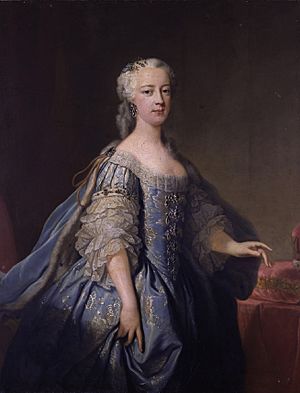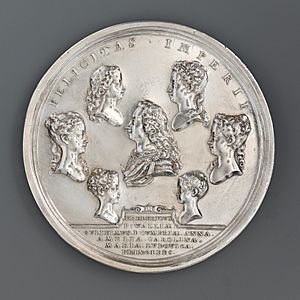Princess Amelia of Great Britain facts for kids
Quick facts for kids Princess Amelia |
|||||
|---|---|---|---|---|---|

Portrait by Jean-Baptiste van Loo, c. 1738
|
|||||
| Born | 10 June 1711 (New Style) Herrenhausen Palace, Hanover, Electorate of Hanover, Holy Roman Empire |
||||
| Died | 31 October 1786 (aged 75) Cavendish Square, Soho, London, Kingdom of Great Britain |
||||
| Burial | 11 November 1786 Westminster Abbey, London, England |
||||
|
|||||
| House | Hanover | ||||
| Father | George II of Great Britain | ||||
| Mother | Caroline of Ansbach | ||||
Princess Amelia Sophia Eleonore of Great Britain (born June 10, 1711 – died October 31, 1786) was a royal princess. She was the second daughter of King George II of Great Britain and Queen Caroline. Amelia was born in Hanover, Germany. She moved to England when her grandfather, George I, became king. Princess Amelia lived a quiet life and was the last of her parents' children to pass away.
Contents
Early Life of Princess Amelia
Princess Amelia was born on May 30, 1711, at Herrenhausen Palace in Hanover, Germany. At the time, her father was the Hereditary Prince of Brunswick-Lüneburg. He was the son and heir of the Elector of Hanover. Her mother was Caroline of Ansbach. Amelia was often called Emily by her family.
Moving to Great Britain
On August 1, 1714, Queen Anne of Great Britain and Ireland died. Princess Amelia's grandfather, George I, became the new king. This happened because of a law called the Act of Settlement 1701. Amelia's father became the Duke of Cornwall and Prince of Wales.
Amelia and her family moved to Great Britain. They lived at St James's Palace in London.
Childhood Health and Education
As a child, Amelia was often sick. Her mother hired doctors like Johann Georg Steigerthal and Hans Sloane to help her. In 1722, her mother had Amelia and her sister, Caroline, inoculated against smallpox. This was an early type of immunisation called variolation. It was brought to England by Lady Mary Wortley Montagu.
On June 11, 1727, George I died. Amelia's father became King George II. Amelia continued to live with her father until he died in 1760.
Marriage Plans
Amelia's aunt, Sophia Dorothea, Queen of Prussia, thought Amelia would be a good wife for her son, Frederick. He later became known as Frederick the Great. They discussed this for many years starting in 1723. However, Frederick's father, Frederick William I of Prussia, stopped the plan in 1732. He made his son marry Elisabeth Christine of Brunswick-Bevern instead.
In 1724, Amelia and her sister, the Princess Royal, were considered for marriage to Louis XV of France. But this would have meant Amelia changing her religion to Catholicism. Her father did not allow this marriage.
Princess Amelia's Personality
Princess Amelia really enjoyed riding horses and hunting. Some people, like John, Lord Hervey, did not like her. Lady Pomfret described her as "one of the oddest princesses." She said Amelia did not like flattery and preferred honesty.
Isabella Finch became her Lady of the Bedchamber around 1738. She was good at helping Amelia with any problems.
Later Life and Public Service
In 1751, Princess Amelia became the ranger of Richmond Park. This happened after Robert Walpole, 2nd Earl of Orford died. Amelia caused a big public problem when she closed the park to everyone. Only a few close friends and people with special passes could enter.
This continued until 1758. A local brewer named John Lewis took the park's gatekeeper to court. The court decided that Lewis was right. They said that when King Charles I first closed the park in the 1600s, he still allowed the public to use it. Princess Amelia had to open the park to everyone again.
Charitable Work
The Princess was very generous with her money. She gave gifts to many charities. In 1760, she gave £100 to a group that helped educate poor orphans of church leaders. This money helped pay for a school for 21 orphan girls. In 1783, she agreed to give £25 every year to a new hospital in Northampton.
Princess Amelia's Homes
In 1761, Princess Amelia bought Gunnersbury Park in Middlesex. She used Gunnersbury as her summer home. She added a chapel there. Between 1777 and 1784, she had a bath house built. This building still stands today and is known as Princess Amelia's Bathhouse.
She also owned a house in Cavendish Square, Soho, London. She died there on October 31, 1786. She never married. At the time of her death, she was the last living child of King George II and Queen Caroline. A small picture of her cousin, Frederick of Prussia, was found on her. He had died two months before her. She was buried in the Henry VII Lady Chapel in Westminster Abbey.
Legacy
Amelia Island in Florida, United States, is named after her. So is Amelia County in Virginia, United States.
Images for kids



